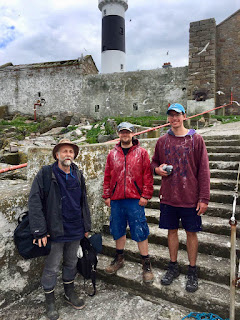We had our first ringing session 21st
June on Maidens’ Rock. Steve, Brian and Niamh all joined to help me out. We
ringed 11 chicks with 2 others too small just yet. I think we might have missed
6 others which had already hatched but with so many nooks and crannies to hide
in it is hard to tell. There are also Oystercatcher
chicks around but they need to grow a bit before they are big enough to ring,
usually they are much faster than tern wardens at that stage!
 |
| Steve, Niamh and myself ringing chicks under NPWS license on Maidens' Rock. Photo: Brian Burke |
 |
| A confused Arctic Tern chick, just ringed (and photographed!) under NPWS license. Photo: Brian Burke |
There has
been an influx of new nests on Maidens’ rock but unfortunately this is likely
due to the Lamb colony collapse over the weekend of 10th/11th
June where there were at least 90 pairs. The Maidens’ colony has grown from
about 30 pairs to approximately 90, it is impossible to tell for sure due to
relaying of original pairs and continual relaying of new pairs due to predation
or weather effects.
 |
| Very well camouflaged Oystercatcher chicks. Photo taken under NPWS license by Andrew Butler. |
I do regular visits throughout the
season to track the progress of the colony and hopefully get some Roseate Terns
nesting too.
 |
| As always, Johnny gets us on and the islands safe and dry. Thanks Johnny! |
Events
The Dalkey Tern Watch is running every Tuesday Evening 5-8pm until the
end of July at Coliemore Harbour as well as Weekend events. During July the
South Dublin BirdWatch Ireland branch also run the event from 6:30-8pm, they
have been doing so for many years.
The next events are this weekend,
Sunday 2nd, 11am-1pm. I’ll be running the Tern Watch as normal and
then 2:30, 3:30 & 4:30pm I will be running 45 min guided walks on Dalkey
Island. You need to make your own way to the Island (ferry), meeting at the
pier on the Island. The event is weather/boat dependant.
 |
| The species list from our watch event on Tue 23rd May. |
All events will be advertised on: http://events.dlrcoco.ie/https://www.facebook.com/BirdWatchIreland/https://twitter.com/BirdWatchIEAnd locally in Dalkey town centre.






